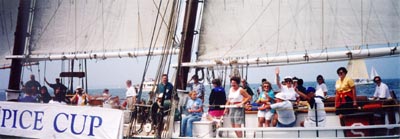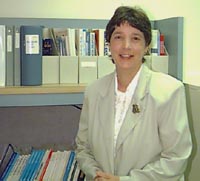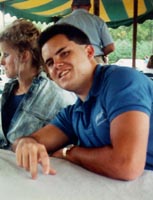 Sailing on the Good Ship Hospice
Sailing on the Good Ship Hospice Sailing on the Good Ship Hospice
Sailing on the Good Ship Hospice
This weekend's regatta
and parties are, for many, what life is all about.
So, others say, is hospice.
by Carol Glover
photo courtesy of Hospice Cup Hospice Cup supporters overlook the race from the decks of Lady Baltimore.
Hospice Cup is about life.
Racing sailors say they're never more alive than when they're rounding the marker, eyeing the other racers, changing direction and head sails, running at the intersection of wind and water. The Hospice Cup Regatta puts them at this intersection over and over again for three or four hours.
Party lovers live for the kind of party Regatta planners throw. Friday, the really big dogs party the night away at Tolerance, the home of St. John's College president Christopher B. Nelson and his wife Joyce Olin Nelson. The wine flows, the gourmet fare tantalizes and gentle breezes waft off Spa Creek.
Hospice Cup supporters say they live for the thrill of an afternoon on
Lady Baltimore, the Hospice  Cup observation
boat, breathing the Bay's clean salty air, following the racers' billowing
white sails and munching the gourmet goodies lovingly prepared by local
caterers.
Cup observation
boat, breathing the Bay's clean salty air, following the racers' billowing
white sails and munching the gourmet goodies lovingly prepared by local
caterers.
photo by Christy Grimes Cheryl Shirk assembles crews for Hospice of Anne Arundel Medical Center.
Final Voyages
Yet hospice, at first glance, seems to be all about death. Unless you've experienced hospice firsthand.
Ask most any of the families who've entrusted care of loved ones in their last days to the regatta's six sponsoring hospices - Hospice of Anne Arundel Medical Center, Hospice of the Chesapeake, Calvert Hospice, Montgomery Hospice Society, Hospice of Charles County or Hospice of Northern Virginia. They'll tell you hospice is all about life.
Like the race itself, hospice succeeds on teamwork and focuses on life with the patient at the helm. Again and again, people who have experienced hospice firsthand say they have never appreciated and embraced life more or been enveloped with more love and attention than during the journey toward death.
"We empower the patient and the family, allow them to be decision makers. We make sure their voices are honored and respected," explains Kendra Logan, a nurse who is patient care coordinator at Calvert Hospice.
At death's door is not a place most hospice patients and their families choose to be. Beyond that, hospice makes sure the final journey is traveled with as many choices as humanly possible.
"It's the patient's choice whether to be at home or in a residential hospice," adds Cheryl Shirk, supervisor of Hospice of Anne Arundel Medical Center. "They identify the important people who will make up their unit." That's the team that will help to raise and lower the sails over the next six months. To enter most hospice care programs, a person's lease on life must be no longer than six months.
Patients pick their own crew team of family and friends to surround them on this final journey, but also within reach 24 hours a day, seven days a week is hospice's own crew: the nurse who directs the care, the social worker, psychologist, home health aides, chaplain and volunteer caregiver.
How does the hospice crew get aboard?
Glenn Smith had bone cancer. The 27-year-old Navy man had undergone treatment at Bethesda Naval Medical Center and was in remission for three months before the cancer returned, this time for good. "Glenn was mad at everything," recalls his father, Earl Smith of Huntingtown.
photo courtesy of Ronnie and Earl Smith Glenn Smith made his final voyage on the Good Ship Hospice.
Ronnie and Earl Smith cared for their son Glenn for four months at home. "As a dad I'm Mr. Fix It," says Earl, "but I couldn't fix it. Nobody could."
Ronnie, a hospice caregiver and bereavement counselor herself, told Glenn she would like to have hospice come. "He pretended that he wasn't sick," his mother remembers. "'No,'" he said, "'I don't want the sickness in the house.'
"His temperature was a constant 102 degrees, he'd lost weight."
"'You know,' I said, 'I need hospice. They will come in and help your dad and he help you.'
"'All right,' he said."
That's when the hospice crew comes on board.
photo courtesy of Ronnie and Earl Smith Earl and Ronnie Smith cared for their son, Glenn, four months at home before seeking help from hospice.
The nurse is first mate of the hospice crew, but the patient is captain.
Logan, of Calvert Hospice, thinks of it in another way: "A hospice nurse is to a patient what a midwife is to a baby. You can help with the destination even though you can't travel the road yourself."
When patient and family are ready for hospice, Logan follows a routine shared by most of the hospice beneficiaries of the annual Hospice Cup fund-raiser.
"I set up a time to talk to the family, initially to educate them about hospice. The hospice movement provides supportive palliative care, no heroic measures to prolong life. 'Do you think this will be helpful?' I ask."
A primary nurse next comes aboard, visiting as many times during the week as needed. This crew member assesses the needs of the patient and the family and works with the physician.
Medicare covers hospice, as do some private insurance companies. But there are still uncovered costs, and many people who have no hospice coverage. That's where the Hospice Cup Regatta come in, along with private donations and other fund-raisers. By the time this year's extravaganza is complete, Hospice Cup will have raised nearly $3.8 million in 18 years with about 80 percent flowing right into the hospices it supports.
"Without hospice services," Earl Smith believes, "we would have been forced to put Glenn back in Bethesda. Knowing what to do, knowing you could call a hospice nurse anytime, we felt we could do this. Whatever the need, they provided."
"It was easier once the nurse took charge," says Ronnie Smith. She gave us a book, and she'd tell us, 'it's time to read page so and so.'"
The Smiths, with their daughter, were Glenn's crew. Because of Ronnie's experience as a hospice volunteer they took on dual roles, family caregiver and relief crew. The three of them took turns relieving each other the way a volunteer respite caregiver from hospice does in other families.
Most families need a respite care volunteer to help tend the sails.
Dorothy Clarke, at right, who crews often for Calvert Hospice, will tell you that being a hospice volunteer is now her career. "I was a computer specialist and am now retired. hospice is a passion with me," says Clarke.
Disturbed at the way her father died, Clarke "couldn't see other families go through what we did with my father. Hospice training made me work out these issues."
"My families are important to me. I want them to see my service as a service of love, a gift of love. The person who receives the gift shouldn't feel ashamed or condescended to. My goal is to provide whatever the family and person needs. I call them right away, introduce myself and set up a personal interview," the volunteer says.
Clarke relieves family caregivers, perhaps taking them out shopping or to get their hair done. She also brings them small gifts, not out of necessity but as a measure of her involvement and caring: a favorite food, a small trinket. She also makes sure patient and family are getting all they need. "Through conversation and observing, I determine what additional needs they might have and whether I can do it or call the hospice office for help," Clarke says.
Her duties do not end there.
"When the time comes, I help the patient to die in a peaceful, loving environment. I spend time singing to them. When they're frightened at death, I touch and soothe them. If the family needs help after the death, I bathe the body, help the family shop for funeral clothes, help them dress their loved one and make funeral arrangements."
Most volunteers do similar tasks, but each has special ways. Paul Carpenter, at right, retired Army lieutenant colonel and college instructor, is a volunteer with Hospice of Anne Arundel Medical Center. He takes his patients who are still strong out and about: to the beach, shopping or to lunch.
photo by Christy Grimes
"I took one man for a ride. We visited where he used to live, the house he built. I also transport them to the oncology center, to the doctor or to pick up prescriptions. I have a lot in common with most men and can talk fishing, flying and about different war experiences. One patient brought up the topic of spiritualism and Indian lore. I read up on it and we swapped stories," Carpenter says.
The Journey's Rewards
In a race, the finish brings its rewards. In sailing it might be the satisfaction of the competition, a trophy, a pat on the back, an ice cold beer. For hospice, the satisfaction is bittersweet. Death is the finish line. Those of us who are not involved in the hospice movement might question the satisfaction. But it's there twofold and it glows: satisfaction for the volunteer caregiver and satisfaction for the family.
"My life is enriched, my knowledge has increased," Clarke reflects. "There's something new with each patient. I travel and experience things through my patients' lives. They share so much of their lives with me, it enriches me.
"It makes me aware of all the people in our society who are hurting. It's caused me to be reflective, introspective, appreciate life more and recognize my mortality. The brevity of life, not to be wasted, causes me to make the most of every moment. I have to let people know now that I love them, hug them. I have now; I don't have later."
Earl Smith has talked with New Bay Times about Glenn and hospice from his home in Huntingtown. "I'm sitting right now in the same place as I was when he died four years ago, on September 14, 1995. It was the best possible place to be," says he.
His wife Ronnie agrees: "As a mother I wanted to help my children fulfill their dreams: guitars, basketball. My son didn't want to go to a hospital. I sat on the arm of his chair, my arms around him, singing when he died."
Hospice Cup Regatta XVIII begins at 11am Sat. Sept. 18.
Tickets for the 4pm buffet shore party and silent auction with entertainment and music on Holly Beach Farm Road on Whitehall Bay are still available for $60: 703/538-2062.
| Issue 37 |
Volume VII Number 37
September 16-22, 1999
New Bay Times
| Homepage |
| Back to Archives |